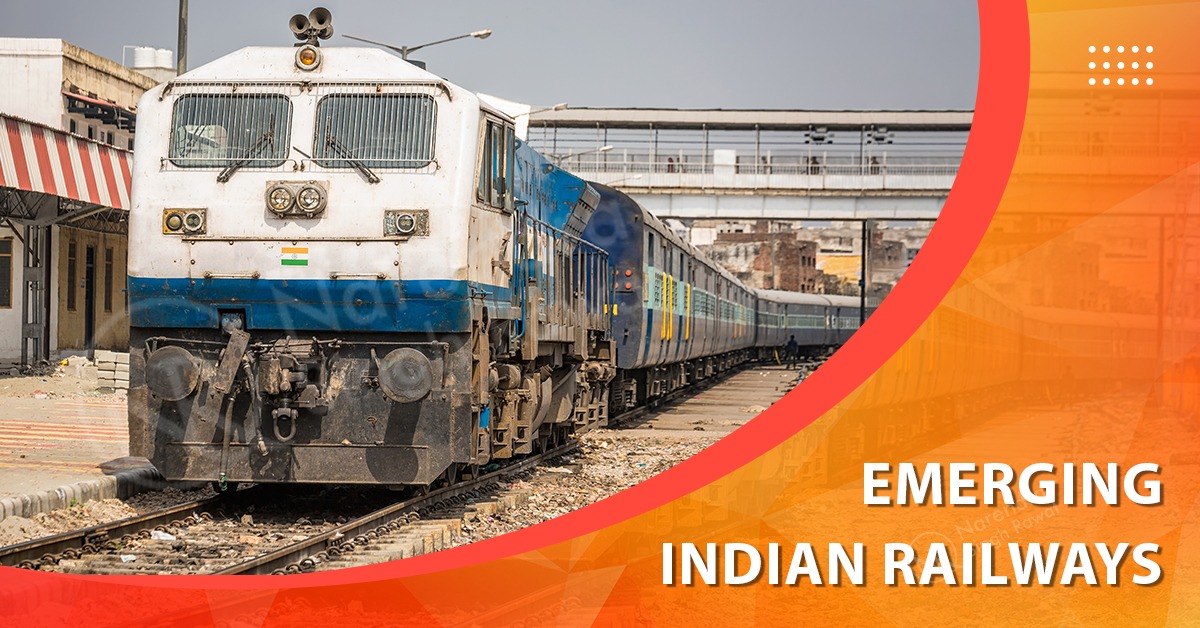Indian Railways is India's biggest Government institution, giving more than 17 Lakh people employment. India has the 4th largest railway system in the world, behind only US, Russia, and China. Indian Railways is the biggest railway system in Asia and the second biggest railway system in the world. In India, the first train was run between Mumbai and Thane.
After independence, there is a new chapter started in the development of the Railway Government of India established its separate Ministry of Railways. The total responsibility of Railways is on the Ministry of Railways.
With the passage of time, the Indian Railway System has grown into such a big organization that it has become Asia’s largest and the World’s second-largest organization in terms of its route length.
During the period covering from 1951 to 2002, Indian Railways recorded a growth rate of 3.9 percent per annum in respect of passenger traffic and 4.5 percent per annum in respect of freight traffic. The railways employ about 16 lakh workers—the largest number of any undertaking in the country.
All these have led to a huge loss of revenue for Indian Railways in different years. The budgetary support to the Railways declined continuously from 75 percent of the Railways Plan Outlay during the Fifth Plan to 42 percent of outlay in the Seventh Plan and further to 23 percent of the outlay during the last four years of the Eighth Plan. The declining budgetary support has adversely affected the Railway’s plan for the acquisition of locomotives, coaches, and wagons.
Railway Development under the Five-Year Plans:
Among all the modes of transport in India Railway transport is the most important one. Considering its importance, the Government laid the greatest emphasis on the development of Railways in the successive Five-Year Plans of the country.
The main objective of the planning for the development of the Railway Transport system in India was to expand Railway traffic in such a manner as to avoid bottlenecks in the entire production process and also to ensure an efficient and well-developed rail transport system. In the first six Five Year Plans, a total outlay of Rs 12,000 crore was earmarked for the development of Railways.
Beneficial Effects of Railways on the Indian Economy:
The construction and expansion of a huge network of Railways in India has been creating a number of beneficial effects on the economy of the country.
Following are some of the beneficial effects of Railways on the Indian economy:
(i) Benefit to Agriculture:
Indian agriculture is getting a lot of benefits from Indian Railways. In the absence of Railways, markets for agricultural commodities would have been restricted only to local areas. But the expansion of the Railway network has made it possible to extend the area of the market for our agricultural products to the extreme corners of the country. Moreover, railways supply basic inputs to agriculture in time. Railways have helped to maintain a better distribution of agricultural produce and bring about uniform prices of these goods throughout the country.
(ii) Benefit to Industry:
Railways transport is considered an important factor behind the industrialization of a particular region. Indian railways have made valuable contributions towards the establishment of some important industries in India. Indian Railways provide easy and cheap transportation facilities for carrying fuels and raw materials to the industrial units and also for distributing their finished products to various distant markets.
The expansion of railways has resulted in the development of the cotton textiles industry of Bombay, the jute industry of Bengal, the tea industry in Assam and Bengal, etc.
(iii) Benefit to Trade:
A well-developed network of railways has resulted in the expansion of trade in India particularly of bulky and perishable commodities. The markets for fruits, eggs, fish, milk, vegetables, etc. have expanded due to railway traffic. Moreover, Railways have expanded external trade, multiplying the volume of exports and imports.
(iv) Social Benefits:
Indian railways have also contributed to the development of Indian society by reducing the isolation between villages, regions, and also between various communities. Railways have removed caste prejudices and have broken up the joint family system. Railways have united the country into a big one by raising geographical mobility.
(v) Political and Administrative Benefits:
Indian railways are regularly rendering a lot of political and administrative benefits to a vast country like India. For maintaining internal security and external safety, quicker movement of police and army from one region to another region of the country has become possible through its well-developed network of railways. Railways are thus very much useful for maintaining sound administration in a vast country like India.
The alternative source for financing the Railway plans, including market borrowings, has also become uncertain and expensive. The Railways, therefore, have been forced to rely more on internal generation, which is estimated to be around 55 percent in 1995-96.
Moreover, the administrative cost of the Indian Railways has been increasing rapidly. With nearly 1.55 million employees, the Indian Railways are the largest employer among public sector undertakings in the country.

